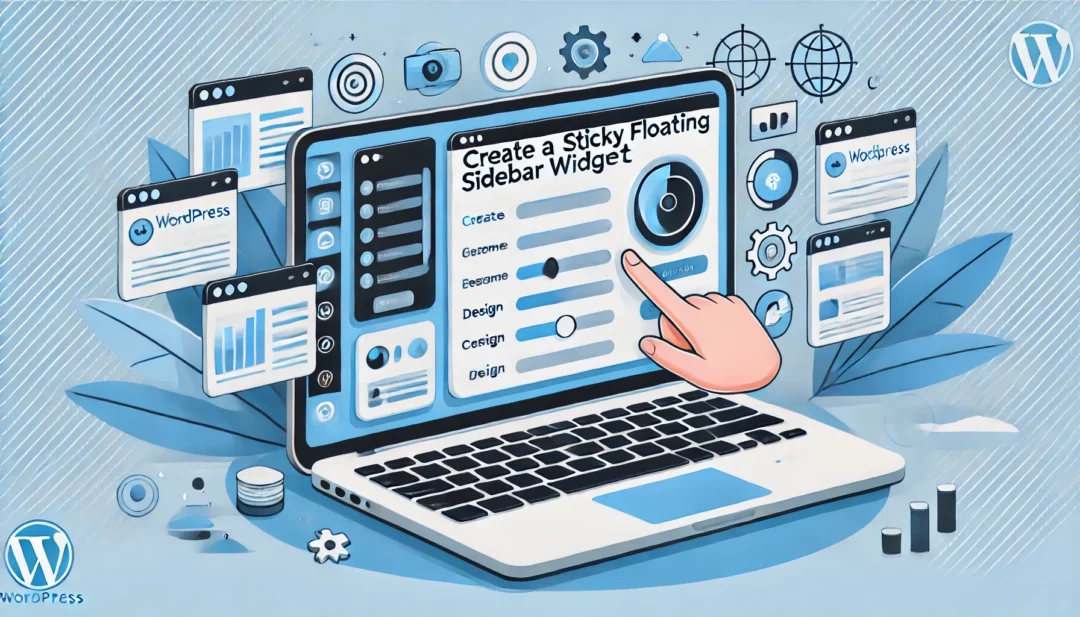
A sticky floating sidebar widget can transform your WordPress site, keeping important content visible as users scroll. Whether it’s a call-to-action, navigation menu, or promotional content, this feature enhances user experience and boosts engagement. The good news? You can create one without diving too deep into coding.
To get started, install a plugin or tweak your theme settings for basic functionality. Customize the widget’s appearance and behavior to fit your site’s design. Finally, test its responsiveness to ensure it works seamlessly across devices. With just a few steps, you’ll have a functional, eye-catching sidebar that sticks exactly where you want it.
Understanding Sticky Floating Sidebar Widgets
Sticky floating sidebar widgets remain visible as users scroll, ensuring access to essential content without requiring backtracking. These widgets enhance user navigation, highlight critical information like call-to-action buttons, and improve engagement on WordPress sites.
By staying fixed in a designated area, sticky widgets provide constant visibility for elements such as subscription forms, contact links, or popular posts. This approach enables a seamless browsing experience, especially on content-heavy pages.
You implement sticky floating sidebar widgets using CSS code, JavaScript, or plugins. Each method has unique advantages and supports different skill levels and customization needs. Knowing the widget’s compatibility with your WordPress theme and layout ensures proper display and functionality. Additionally, optimizing the widget for responsiveness is essential to maintain a user-friendly design across devices.
Why Use A Sticky Floating Sidebar Widget In WordPress
A sticky floating sidebar widget enhances user experience by keeping essential content visible while users scroll. It ensures critical elements like navigation menus, social media icons, or CTAs remain accessible, boosting engagement and conversion rates.
Benefits Of Sticky Sidebars
- Improved Navigation: Sticky widgets allow users to quickly access key links or sections, improving site navigation without interrupting their browsing flow. For example, users can quickly reach popular pages or product categories.
- Enhanced Content Visibility: Essential elements like subscription forms, promotional banners, or featured posts stay in view, increasing their chances of interaction. This is particularly effective for highlighting offers or gathering leads.
- Increased Engagement: Keeping high-value content accessible encourages user interaction with forms, links, or ads. For instance, displaying related articles can extend session duration.
- Mobile Usability: When optimized for responsiveness, sticky sidebars improve usability on smaller devices by ensuring important elements aren’t lost in long scrolls.
- Call-To-Actions (CTAs): Buttons inviting users to subscribe, sign up, or shop now are more effective when always visible on the sidebar.
- Social Media Links: Floating social icons make it easy for users to share content or connect with your profiles directly.
- Post Navigation: For blogs or news sites, a sticky “Recent Posts” or “Categories” widget simplifies browsing through available content.
- Advert Monetization: Ad placements in sticky widgets ensure high visibility, offering value for advertisers and maximizing revenue opportunities.
- Popular Content Banners: Highlighting top-performing posts or products through a sticky element keeps them prominent to drive more traffic or sales.
Tools And Plugins For Creating Sticky Sidebars
Sticky sidebar widgets in WordPress are easier to implement using reliable tools and plugins. These solutions simplify customization without extensive coding knowledge.
Top WordPress Plugins For Sticky Widgets
- Q2W3 Fixed Widget for WordPress
This plugin provides a straightforward method to make widgets sticky. It’s highly customizable and supports optional margin adjustments, user role control, and device-specific behavior.
- Sticky Menu & Sticky Header
Ideal for adding sticky effects to menus and headers. It supports sticky sidebar functionality, ensuring compatibility with most themes.
- WP Floating Menu
This plugin allows you to create sticky, floating menus or widgets using a drag-and-drop builder. It offers theme-based styling options for seamless integration.
- Elementor
If you’re using Elementor for page building, you can use its built-in sticky functionality to create sticky widgets without additional plugins.
- Custom Sidebars – Dynamic Widget Area Manager
This tool enables you to assign sticky widgets to specific pages, posts, or templates, providing advanced control over your sidebar content.
- Compatibility With Theme
Ensure the plugin works well with your current WordPress theme. Check reviews and documentation to avoid layout issues.
- Ease Of Use
Opt for plugins with intuitive interfaces. Beginners may benefit from drag-and-drop features, while developers might prefer those with more advanced settings.
- Customization Options
Evaluate the customization capabilities. Plugins like Elementor or WP Floating Menu offer advanced styling, while simpler options like Q2W3 Fixed Widget focus on functionality.
- Performance Impact
Test for performance drops. Plugins with poor coding can negatively impact site speed, so prioritize well-reviewed options.
- Support And Updates
Select plugins with active support communities and developer updates. Regular updates ensure compatibility with the latest WordPress versions.
By leveraging the right tools, you can enhance your WordPress site with sticky floating sidebars, improving user experience and boosting engagement.
How To Create A Sticky Floating Sidebar Widget
Creating a sticky floating sidebar widget in WordPress enhances accessibility and highlights important content as users scroll. Follow these simple steps to implement this feature effectively on your website.
Step 1: Install A Suitable Plugin
Choose a plugin designed for sticky floating sidebars. Popular options include Q2W3 Fixed Widget or Sticky Menu & Sticky Header. Navigate to the WordPress admin dashboard, go to Plugins > Add New, and search for your preferred plugin. Click Install Now, then activate the plugin after installation.
Step 2: Configure Plugin Settings
Access the plugin settings under Appearance > Widgets or within the plugin’s settings page itself, depending on the tool. Enable the sticky feature by selecting the specific widget you want to fix, checking the corresponding “Fixed Widget” or “Sticky” box. Use additional options from the plugin settings, such as margins or visibility rules, to fine-tune the widget’s behavior. Save the settings when you’re done.
Step 3: Customize Sidebar Appearance
Ensure your sidebar matches the site’s design and fits within the user interface. Adjust visual aspects, such as width, background color, or font, through the Customizer under Appearance > Customize. If more flexibility is needed, apply custom CSS through the Additional CSS section or within your plugin’s advanced settings. Testing different styles helps maintain a cohesive look while keeping content visible and appealing.
Step 4: Test The Sticky Functionality
Scroll your page to confirm the sidebar remains fixed at the desired position. Check the widget’s responsiveness on mobile and desktop displays to ensure proper alignment. If the widget overlaps other content or behaves unpredictably, revisit the plugin settings or adjust the CSS. Clear your site cache and retest for updated effects.
Troubleshooting Common Issues
Troubleshooting ensures your sticky floating sidebar widget functions correctly and enhances user experience. Below, explore solutions to common problems.
Sticky Sidebar Not Working
Identify the cause when a sticky sidebar doesn’t function as expected.
- Check Plugin Settings
Ensure the plugin settings are configured properly. Open the plugin’s options panel and verify that the sticky functionality is enabled for the desired widget.
- Verify Theme Compatibility
Certain themes conflict with sticky plugins due to custom CSS or JavaScript. Switch to a basic theme temporarily to confirm compatibility.
- Inspect CSS Rules
Incorrect CSS classes or styles can prevent the sidebar from staying fixed. Verify that the position: sticky; or equivalent is applied to the correct element.
- Test Browser-Specific Behavior
Browser quirks sometimes cause issues. Test functionality on popular browsers like Chrome, Firefox, and Safari.
- Resolve JavaScript Conflicts
Other scripts or plugins may interfere with sticky behavior. Temporarily disable non-critical plugins and check if the issue persists.
Performance And Compatibility Concerns
Optimize your sticky sidebar to maintain performance and cross-device compatibility.
- Minimize Resource Usage
Limit the number of widgets in your sidebar. Excessive elements reduce page loading speed and user experience.
- Test Responsiveness
Manually test or use a tool, like Google’s Mobile-Friendly Test, to confirm the widget adapts across screen sizes without overlap or cut-offs.
- Avoid Cumulative Layout Shifts (CLS)
Large, sticky elements can contribute to CLS, impacting Core Web Vitals. Use fixed heights and margins to reduce unexpected movement.
- Monitor Site Speed
Heavy plugins or unoptimized sidebars increase page load times. Compress images, use a caching plugin, and review your site speed with PageSpeed Insights.
- Update Regularly
Ensure your plugins and themes stay updated to avoid compatibility issues with the latest WordPress version.
Conclusion
Creating a sticky floating sidebar widget in WordPress is a powerful way to enhance your site’s usability and engagement. By keeping crucial elements like CTAs, navigation links, or subscription forms visible, you ensure users can easily interact with your most valuable content.
With the right tools and techniques, implementing this feature is straightforward and customizable to fit your site’s design. Whether you use plugins, custom CSS, or JavaScript, the key is to focus on compatibility, responsiveness, and performance.
A well-optimized sticky sidebar not only boosts user experience but also drives conversions and revenue opportunities. Take advantage of the available resources, test thoroughly, and keep your site updated to maintain a seamless experience for your audience.
Frequently Asked Questions
What is a sticky floating sidebar widget?
A sticky floating sidebar widget is a feature that keeps specific content, like navigation menus or CTAs, visible as users scroll through a webpage. This enhances user experience by ensuring important elements remain accessible without requiring users to scroll back.
How does a sticky sidebar improve user engagement?
Sticky sidebars improve engagement by keeping key content like subscription forms, CTAs, or popular posts highly visible. This encourages users to interact with critical elements, leading to more clicks, sign-ups, or conversions.
Can I create a sticky sidebar without coding skills?
Yes, many WordPress plugins, such as Q2W3 Fixed Widget or Sticky Menu & Sticky Header, allow you to create sticky sidebars without coding. Simply install a plugin, configure the settings, and customize your sidebar’s appearance.
Are sticky sidebars mobile-friendly?
Sticky sidebars can be mobile-friendly if designed correctly. Ensure they are responsive and optimized for smaller screens, so content is accessible without obstructing the mobile user experience.
What types of content should I include in a sticky sidebar?
Sticky sidebars are best for showcasing CTAs, subscription forms, social media links, popular posts, navigation menus, or promotional banners. These elements increase visibility and encourage interaction with high-value content.
Can a sticky sidebar affect website performance?
Yes, if not optimized, a sticky sidebar can impact site speed. Reduce performance issues by using lightweight plugins, optimizing code, and regularly updating your plugins and themes.
Which plugins are best for creating sticky sidebars in WordPress?
Popular plugins for sticky sidebars include Q2W3 Fixed Widget, Sticky Menu & Sticky Header, WP Floating Menu, Custom Sidebars, and Elementor. Each offers unique customization and compatibility features for different WordPress themes.
How do I troubleshoot sticky sidebar issues?
Common issues with sticky sidebars include plugin conflicts, CSS problems, or theme incompatibility. Check your plugin settings, test for JavaScript errors, and ensure your theme supports sticky elements.
Can I customize my sticky sidebar’s appearance?
Yes, most plugins provide options to customize your sidebar’s design, including size, position, colors, and responsiveness. You can also add custom CSS for more advanced styling.
Why should I update my plugins and themes regularly?
Regular updates ensure compatibility, fix bugs, and improve performance. Updated plugins and themes help maintain the functionality of your sticky sidebar while keeping your website secure and efficient.






